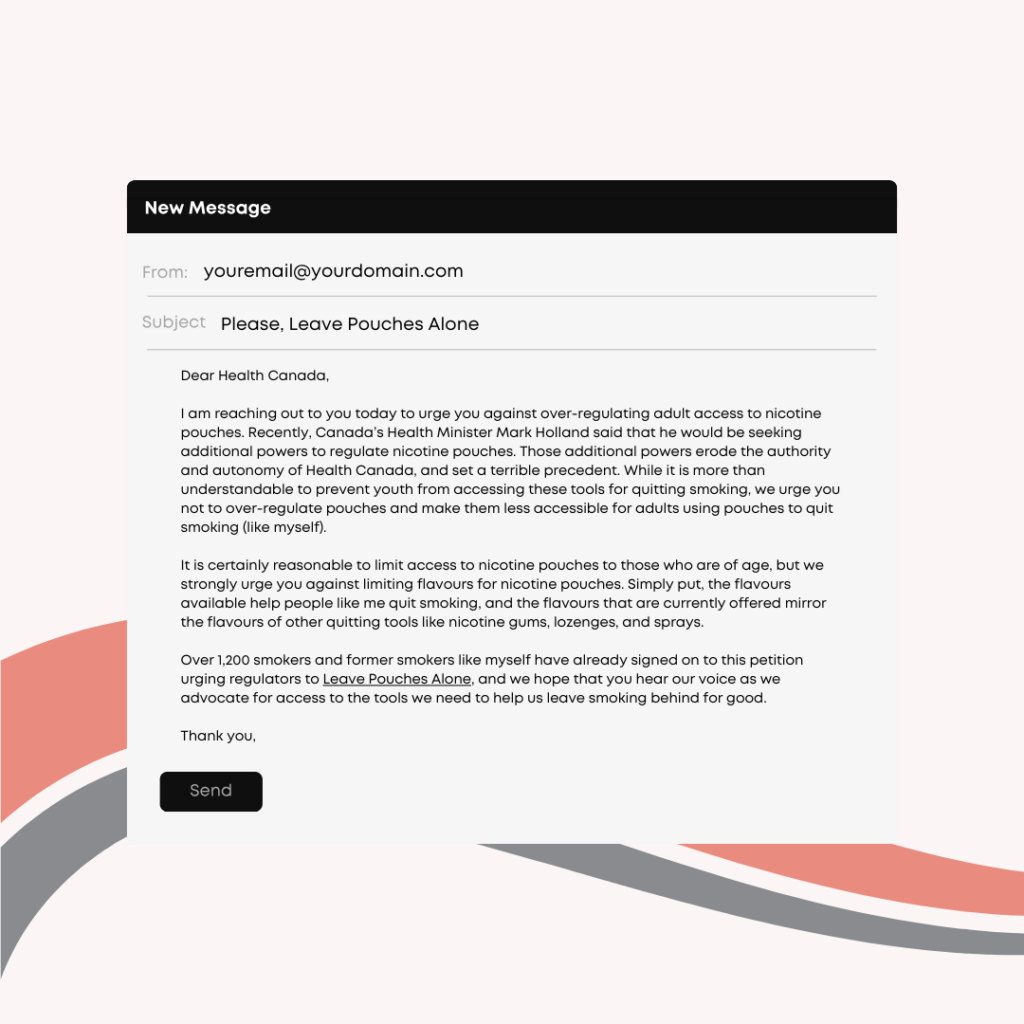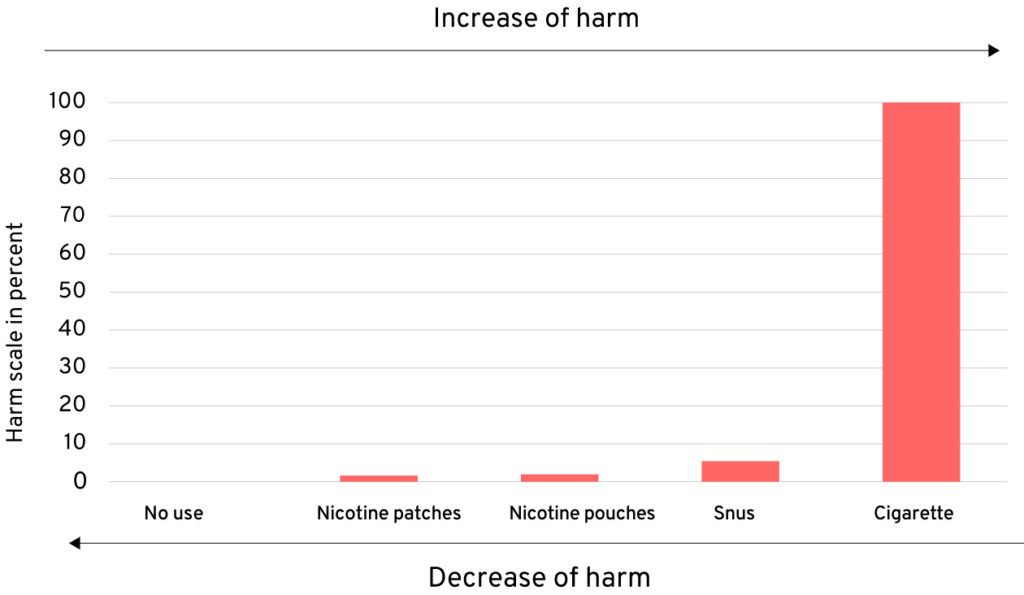We need your help
We need your help. The federal Health Minister Mark Holland is expanding his power to regulate nicotine pouches, and potentially all nicotine products that smokers use to quit. This could include bans on flavours, restrictions on where pouches are sold, and possibly a ban. All this despite the fact that Health Canada has approved these products to help smokers quit. Heavy handed restrictions ultimately make it harder to quit, and no one wins in that scenario. Sign out petition in support of our campaign to tell Mark Holland to “Leave Pouches Alone”
Email Health Canada
Now you can email health Canada by filling out the form below. Just add your information and an email will be sent in your name automatically. You can see the content of the email in the example below:
Send an email

Sign the petition
People have signed the petition
Every year 20,000 Canadians needlessly die from smoking-related diseases. As nicotine pouches have come on to the market, Mark Holland has sought to restrict access to these less risky alternatives, ultimately making it harder to quit.
Sign your name in support of our “Leave Pouches Alone” and tell legislators and regulators that harm-reduction products are vital for public health!
Help Save nicotine Pouches
Sign the petition
SHARE ON SOCIAL MEDIA
What are nicotine pouches?
Nicotine pouches are tobacco-free, oral nicotine products used to help smokers quit smoking. They are placed under the lip, where the nicotine is absorbed through the mouth’s lining.
In Canada, legal nicotine pouches are regulated by Health Canada as a tool to help smokers quit, and the rules for pouches are identical to other smoking cessation tools that have been on the market for years, if not decades. Those other tools for smokers to quit include sprays, patches, gum, and lozenges.
What is the risk associated with nicotine pouches?
The German Federal Institute for Risk Assessment (BfR) published a comprehensive review on nicotine pouches, and the results are pretty eye opening. On a harm scale, with 100 representing the risk from smoking, and 0 representing not consuming any product with nicotine, the BfR gave nicotine pouches a score of 1, which is exactly the same as the risk from nicotine patches, gums and sprays.

How do we prevent youth accessing nicotine pouches?
Nicotine pouches are meant for adults to quit and stay away from cigarettes, not for minors.
For minors and the products attracting minors to nicotine, the authors cite evidence that these pouches have very limited appeal (11-12%) to people who have never consumed tobacco products before. That’s good news! In comparison, for smokers or those who use chewing tobacco, interest in nicotine pouches skyrockets to 75%.
Despite the low level of interest, experimentation by youth isn’t something to be ignored; therefore, we advocate for regulations that protect adults and discourage underage uptake. Sensible restrictions include age restricting sale to adults, and requiring that they be sold from behind the counter at retail outlets like other age restricted goods.
Where Has Harm Reduction Lowered Smoking Rates?
Sweden, a country where these low risk alternatives are widespread, is an example of how harm reduction actually works in practice.
The German BfR researchers clearly point out that Sweden is the only country in Europe where lung cancer isn’t at the top of the list for cancer mortality. Lung cancer in Sweden, because of the embrace of tobacco harm reduction, is the lowest in all of Europe’s 40 countries. In Canada, lung cancer is the leading cancer killer, with well over 20,000 Canadians dying annually.
The Debate
Where And How Should Nicotine Pouches Be Sold?
Nicotine pouches should be sold in retail outlets where cigarettes are sold. It is important that when smokers go to buy their cigarettes, they are informed or reminded that significantly less risky products exist, and that those products can be used to help them quit. Removing nicotine pouches from these retailers makes it more difficult for smokers to buy them, which discourages their access to products that could help them leave cigarettes behind for good. Nicotine pouches should be restricted to a ‘behind the counter’ product like other age restricted goods.
Should Flavours Be Allowed For Nicotine Pouches?
Yes. Flavours are an important part of why a smoker may try nicotine pouches, and opt to use them over continuing to smoke. While flavours may be enticing to minors, simple rule changes like age restrictions and behind the counter sales help solve the problem of youth access. Other tools used to help smokers quit come in flavours like mint, fresh fruit, cool berry, and mild spearmint. Given that Health Canada has regulated nicotine pouches in the same way, it is appropriate to allow flavours like Canada already does for nicotine gums, lozenges and sprays.
Should Nicotine Products Be Allowed To Be Marketed?
Yes, it should be legal for these products to be marketed to smokers as a tool to help them quit. So long as they are marketed in that way, and not targeted towards minors in any way, educational advertising should be permitted. This is exactly how other smoking cessation tools are currently marketed in Canada.
Should Nicotine Pouches Be Age Restricted?
Yes, these products should be restricted for adults only, and retailers should be required to ask for identification for any customer who appears under the legal age to buy tobacco products.
The Petition
We need your help. Provincial governments, like in British Columbia, have restricted the sale of nicotine pouches which ultimately makes it harder for smokers to quit. No one wins in that scenario. Sign our petition in support of our campaign for governments to “Leave Pouches Alone”.
Every year 20,000 Canadians needlessly die from smoking-related diseases. As nicotine pouches have come on to the market, both provincial governments and the federal government have sought to restrict access to these less risky alternatives, ultimately making it harder to quit.
Sign your name in support of our “Leave Pouches Alone” and tell legislators and regulators that harm-reduction products are vital for public health!
Sign the petition
Follow us
Contact Info
712 H St NE PMB 94982
Washington, DC 20002
© COPYRIGHT 2023, CONSUMER CHOICE CENTER